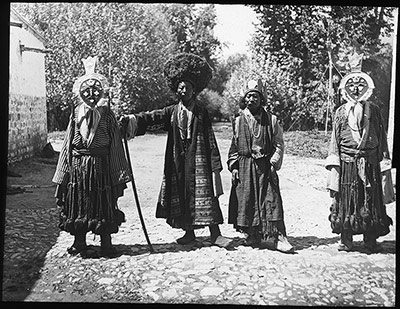
1998.285.177.2 (Lantern Slide)


1998.285.177.2 (Lantern Slide)

Rabden Lepcha?
Sir Charles Bell
August 15th 1921?
Lhasa > Tsetrung Lingka
1998.285.177.2
81 x 81 mm
Lantern Slide
Donated 1983
St Antony's College, Oxford.
Sir Charles Bell's Mission to Lhasa 1920-21
Royal Central Asiatic Society
Rabden Lepcha?
L.144
BL.H.154
Manual Catalogues - Bell's List of Illustrations entry: "[No. of chapter] XXVII. [Subject of Chapter] Amusements. [Subject of Illustration] Four performers in the Kyormo Lung-nga theatrical troupe. All of these four are men, including the second from the right. [Remarks] L.144"
Notes on print/mount - '7' was written in blue-black ink. This has been crossed out in red and replaced with the number notation ('144') from Bell's List of Illustrations. The earlier number seems to relate to a previous numbering system for slides used in lectures 'Year in Lhasa' or 'The Dalai Lama' [MS 31/8/2004]
Other Information - Dates: A flag pole with a Union Jack can be seen in the background, suggesting that this photograph may have been taken when the troupe performed at the Ache Lhamo put on by Sir Charles Bell on 12th-15th August rather than at the Norbu Lingka [MS 16/9/2004]
Other Information - Cultural Background: The reference in the caption to the fact that all the people in this group are men relates to the information cited in his dairy for this event that the Kyormo Lung-nga troupe is the only troupe in Tibet in which women are members [MS 4/6/2004]
Other Information - Description: Bell's diary entry for 4th August 1921 relating to the Kyormo Lung-nga troupe's performance at the Dalai Lama's Ache Lhamo at Norbu Lingka on the 4th - 8th August: "Now appear the Kyor-mo-lung-nga, the most famous of all the theatrical troupes of tibet. The country Kyor-mo-lung from which they take their name and from which their first actors came, is near Lhasa; but nowadays they are joined by people from all parts of Tibet. They are the only one of the troupes in which women take parts. They do more theatrical work and less agricultural than any of the other troupes and their repertary of [?] is the largest. In fine, they are the best of all the troupes, and are the most highly appreciated by the people of Lhasa and elsewhere"
Other Information - Cultural Background: Bell's Diary for 29th July 1921:"The Ache Lhamo troupes who are to perform shortly before the D[alai] L[ama] from the 1st to the 5th of the first 7th month, are the best in Tibet. I am having the two best of the troupes, ie: the Gyang-karas and the Kyi-mo-lung-was, on the 9th and 10th of the first 7th month (12th and 13th of August) because they are allowed to perform in Lhasa town up to the 8th of this Tibetan month. The Tsendron says that the reason why they are not allowed to perform in Lhasa after the 8th is because the people would waste too much time going to see them. They are however allowed to perform in the lingkas outside Lhasa, but the people do not go to see them there as much as they would in Lhasa." [Diary Vol. XI, p.63-64]
Other Information - Cultural Background: Bell's Diary for 31st July 1921:"I propose giving a two days ( Ache Lhamo ) theatrical party to the Prime Minister and other Ministers and officials, whom I have met in Lhasa, and who have called on me. The D[alai] L[ama] is lending the actors' dresses for this. The actors have their own dresses, but, when a high official gives a theatrical party, he lends the actors and actresses their dresses, either from his own store rooms, or after borrowing from his friends. Those owned by the D[alai] L[ama] are of course especially fine." [Diary Vol. XI, p.68]
Other Information - Cultural Background: Bell's Diary for 16th August 1921:"I ask Shesur about the different troupes, and especially about the most popular troupe, the Kyor-mo Lung-nga . He replies, "There are altogether 15 to 20 performers in the Kyor-mo Lung-nga troupe of whom two or three only are girls; the rest are men. These girls are from about 15 to 25 years old; beyond that age women do not act. It is said that the troupe known as the Pim-dum-pa were originally seven sisters ... but now-a-days this troupe consists of men only. ... After the theatricals at Norbu Lingka are ended, a few of the troupes perform for a few days before some of the leading families of Lhasa. The other troupes then return to their cultivation. and are in rather a hurry to get away, because it will be about time to reap their crops by the time they reach their homes. But the Kyor-mo Lung-nga are poor and have no cultivation. Being the best at acting they give rather more performances than do the other troupes, and then split up into small parties and earn their livelihood by petty trading. The one who took the part of Ya-ma-ga-ti trades in the Lhoka province in woollen cloth ( nam-bu ); others in musk in Kong-bo, and so on. Before the seventh month comes round, they return to be coached by Ya-ma-ga-ti in the performances, which have to be given at Norbu Lingka and elsewhere during that month." [Diary Vol. XII, pp.20-21]
For Citation use:
The Tibet Album.
"Actors from the Kyormo Lung-nga theatrical troupe"
05 Dec. 2006. The Pitt Rivers Museum.
<http://tibet.prm.ox.ac.uk/photo_1998.285.177.2.html>.
For more information about photographic usage or to order prints, please visit the The Pitt Rivers Museum.
© The Pitt Rivers Museum